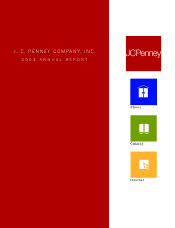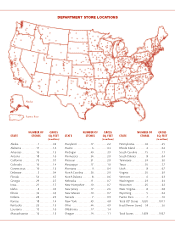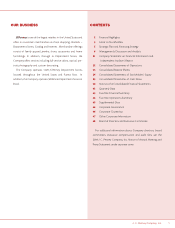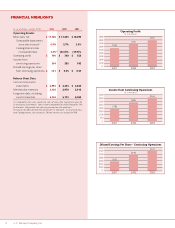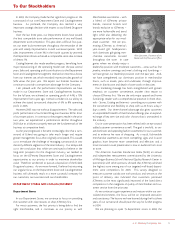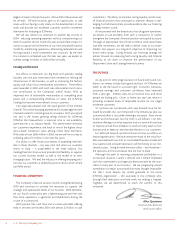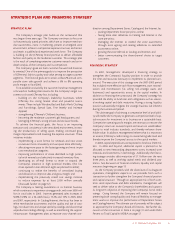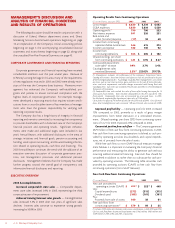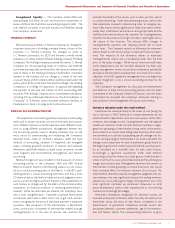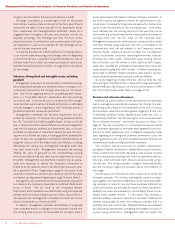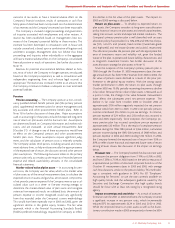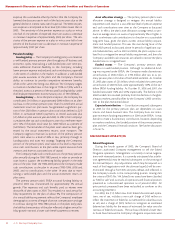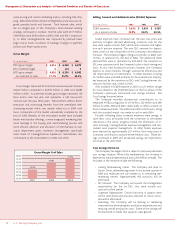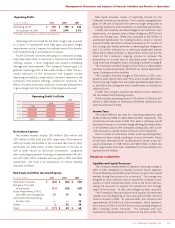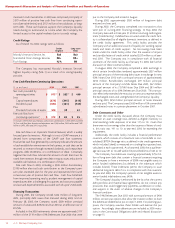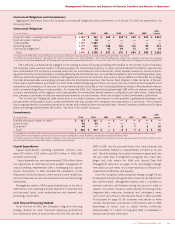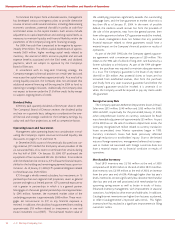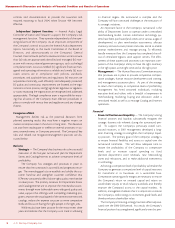JCPenney 2003 Annual Report Download - page 10
Download and view the complete annual report
Please find page 10 of the 2003 JCPenney annual report below. You can navigate through the pages in the report by either clicking on the pages listed below, or by using the keyword search tool below to find specific information within the annual report.
J. C. Penney Company, Inc.8
Management’s Discussion and Analysis of Financial Condition and Results of Operations
margin is also recorded in the period the decision is made.
Shrinkage is estimated as a percentage of sales for the period
from the last inventory date to the end of the fiscal year. Physical
inventories are taken at least annually for all department stores,
SSCs, warehouses and Catalog/Internet fulfillment centers on a
staggered basis throughout the year, and inventory records are
adjusted accordingly. The shrinkage rate from the most recent
physical inventory, in combination with current events and histor-
ical experience, is used as the standard for the shrinkage accrual
rate for the next inventory cycle.
To estimate the effe cts of inf lation/deflation on ending invento-
ry, an internal index measuring price changes from the beginning
to the end of the year is calculated using merchandise cost data at
the item level. Prior to 2002, this index was based on retail prices.
See Merchandise Inventories in Note 1 on page 29 for more details
on the change.
Valuation of long-lived and intangible assets, including
goodwill:
Management evaluates the recoverability of identified intangi-
bles and goodwill, annually and whenever events or changes in cir-
cumstances indicate that the carrying value may not be recover-
able. One of the triggering events for possible goodwill impair-
ment is a “more-likely-than-not” expectation that the reporting
unit will be sold. Given the fact that as of year-end 2003 manage-
ment had been authorized by the Board of Directors to sell Eckerd
and was engaged in active negotiations with interested parties, a
goodwill impairment review was performed.
Management completed the two-step impairment test pre-
scribed by Statement of Financial Accounting Standards (SFAS)
No. 142, “Goodwill and Other Intangible Assets.” In step one of the
test, to determine the fair value of Eckerd as a whole, management
used the bid amounts received, and determined that, as of year-
end 2003, an indication of impairment existed because the carry-
ing amount of Eckerd net assets, including goodwill, exceeded fair
value. In step two, management completed a detailed analysis to
assign fair values to all of the Eckerd assets and liabilities, including
identifying and valuing any unrecognized intangible assets that
may have current value. Management compared the resulting
implied fair value of goodwill to the corresponding carrying
amount and determined that there was no impairment as of year-
end 2003. Management did determine, however, that an adjust-
ment was necessary to reduce the Company’s investment in
Eckerd to its fair value less costs to sell. See further discussion relat-
ed to goodwill in Note 1 beginning on page 29, discussion of the
treatment of Eckerd as a discontinued operation and the fair value
and related tax adjustment beginning on page 10 and in Note 2.
Management also performed the annual evaluation of goodwill
as it relates to the Company’s investment in its Renner Department
Stores in Brazil. The fair value of the Company’s Renner
Department Store operation was determined using the expected
present value of corresponding future cash flows, discounted at a
risk-adjusted rate. Management concluded that there was no evi-
dence of impairment as of year-end 2003.
In addition, management evaluates recoverability of long-lived
assets whenever events or changes in circumstances indicate that
the carrying value may not be recoverable, for example, when a
store’s performance falls below minimum Company standards. In
the fourth quarter, management reviews the performance of indi-
vidual stores. Underperforming stores are selected for further eval-
uation of the recoverability of the carrying amount. If the evalu-
ation indicates that the carrying amount of the asset may not be
recoverable, the potential impairment is measured as the excess of
carrying value over the fair value of the impaired asset.
Management estimates fair value based on a projected discounted
cash flow method using a discount rate that is considered to be
commensurate with the risk inherent in the Company’s current
business model. Additional factors are taken into consideration,
such as local market conditions, operating environment, mall per-
formance and other trends. Impairment losses totaling $26 mil-
lion, $47 million and $42 million in 2003, 2002 and 2001, respec-
tively, were recorded for underperforming department stores and
underutilized Catalog and other facilities. If different assumptions
were made or different market conditions were present, any esti-
mated potential impairment amounts could be different.
As of the beginning of 2002, SFAS No. 142 and SFAS No. 144,
“Accounting for the Impairment or Disposal of Long-Lived Assets,”
became effective. See discussion of the pro forma impact of SFAS
No. 142 on 2001 results under Note 1 on pages 29-30.
Reserves and valuation allowances:
Based on an overall analysis of store performance and expected
trends, management periodically evaluates the closing of under-
performing stores. Reserves are established at the time of closure
for the present value of any remaining lease obligations (PVOL) net
of estimated sublease income, severance and other exit costs, as
prescribed by SFAS No. 146, “Accounting for Costs Associated with
Exit or Disposal Activities.” See further discussion in Note 1 on
page 30. Two key assumptions in calculating the reserve include
the timeframe expected to terminate lease agreements and esti-
mations of other related exit costs. If different assumptions were
used regarding the timing and potential termination costs, the
resulting reserves could vary from recorded amounts. Reserves are
reviewed periodically and adjusted when necessary.
The Company records a provision for workers’ compensation
and general liability risk based on independent actuarial best esti-
mates of claims that have been reported, as well as those incurred
but not yet reported, resulting from historical experience and cur-
rent data. Total estimated claim amounts are discounted using a
risk-free rate. The actuary provides a range of estimated liability,
and the Company targets the provision above the midpoint of
that range.
Income taxes are estimated for each jurisdiction in which the
Company operates. This involves assessing the current tax expo-
sure together with temporary differences, which result from differ-
ing treatment of items for tax and book purposes. Deferred tax
assets and liabilities are provided for based on these assessments.
Deferred tax assets are evaluated for recoverability based on esti-
mated future taxable income. To the extent that recovery is
deemed unlikely, a valuation allowance is recorded. Deferred tax
liabilites are provided for when the Company considers that it is
probable that taxes will be due. Deferred liabilities are evaluated
and adjusted as appropriate, considering the progress of audits of
various taxing jurisdictions. Management does not expect the

